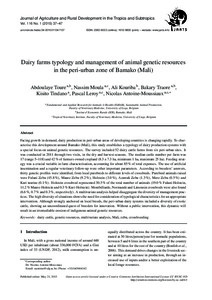Datum
2015-05-21Autor
Toure, AbdoulayeMoula, NassimKouriba, AliTraore, BakaryTindano, KisitoLeroy, PascalAntoine-Moussiaux, NicolasSchlagwort
630 Landwirtschaft, VeterinärmedizinMetadata
Zur Langanzeige
Aufsatz

Dairy farms typology and management of animal genetic resources in the peri-urban zone of Bamako (Mali)
Zusammenfassung
Facing growth in demand, dairy production in peri-urban areas of developing countries is changing rapidly. To characterise this development around Bamako (Mali), this study establishes a typology of dairy production systems with a special focus on animal genetic resources. The survey included 52 dairy cattle farms from six peri-urban sites. It was conducted in 2011 through two visits, in the dry and harvest seasons. The median cattle number per farm was 17 (range 5-118) and 42% of farmers owned cropland (8.3 +/- 7.3 ha, minimum 1 ha, maximum 25 ha). Feeding strategy was a crucial variable in farm characterisation, accounting for about 85% of total expenses. The use of artificial insemination and a regular veterinary follow-up were other important parameters. According to breeders’ answers, thirty genetic profiles were identified, from local purebreds to different levels of crossbreds. Purebred animals raised were Fulani Zebu (45.8%), Maure Zebu (9.2%), Holstein (3.0%), Azawak Zebu (1.3%), Mere Zebu (0.5%) and Kuri taurine (0.1%). Holstein crossbred represented 30.5% of the total number of animals (19.0% Fulani-Holstein, 11.2% Maure-Holstein and 0.3% Kuri-Holstein). Montbéliarde, Normande and Limousin crossbreds were also found (6.6%, 0.7% and 0.3%, respectively). A multivariate analysis helped disaggregate the diversity of management practices. The high diversity of situations shows the need for consideration of typological characteristics for an appropriate intervention. Although strongly anchored on local breeds, the peri-urban dairy systems included a diversity of exotic cattle, showing an uncoordinated quest of breeders for innovation. Without a public intervention, this dynamic will result in an irremediable erosion of indigenous animal genetic resources.
Zitierform
In: Journal of Agriculture and Rural Development in the Tropics and Subtropics. Kassel : Kassel University Press. - Vol. 116, No. 1 (2015), S. 37-47Sammlung(en)
Vol 116, No 1 (2015) (Journal of Agriculture and Rural Development in the Tropics and Subtropics (JARTS))Zitieren
@article{urn:nbn:de:hebis:34-2015011347137,
author={Toure, Abdoulaye and Moula, Nassim and Kouriba, Ali and Traore, Bakary and Tindano, Kisito and Leroy, Pascal and Antoine-Moussiaux, Nicolas},
title={Dairy farms typology and management of animal genetic resources in the peri-urban zone of Bamako (Mali)},
year={2015}
}
0500 Oax 0501 Text $btxt$2rdacontent 0502 Computermedien $bc$2rdacarrier 1100 2015$n2015 1500 1/eng 2050 ##0##urn:nbn:de:hebis:34-2015011347137 3000 Toure, Abdoulaye 3010 Moula, Nassim 3010 Kouriba, Ali 3010 Traore, Bakary 3010 Tindano, Kisito 3010 Leroy, Pascal 3010 Antoine-Moussiaux, Nicolas 4000 Dairy farms typology and management of animal genetic resources in the peri-urban zone of Bamako (Mali) / Toure, Abdoulaye 4030 4060 Online-Ressource 4085 ##0##=u http://nbn-resolving.de/urn:nbn:de:hebis:34-2015011347137=x R 4204 \$dAufsatz 4170 7136 ##0##urn:nbn:de:hebis:34-2015011347137
<resource xsi:schemaLocation="http://datacite.org/schema/kernel-2.2 http://schema.datacite.org/meta/kernel-2.2/metadata.xsd"> 2015-06-10T12:10:16Z 2015-06-10T12:10:16Z 2015-05-21 1612-9830 2363-6033 urn:nbn:de:hebis:34-2015011347137 http://hdl.handle.net/123456789/2015011347137 eng Kassel University Press Urheberrechtlich geschützt https://rightsstatements.org/page/InC/1.0/ dairy cattle genetic resources multivariate analysis Mali zebu crossbreeding 630 Dairy farms typology and management of animal genetic resources in the peri-urban zone of Bamako (Mali) Aufsatz Facing growth in demand, dairy production in peri-urban areas of developing countries is changing rapidly. To characterise this development around Bamako (Mali), this study establishes a typology of dairy production systems with a special focus on animal genetic resources. The survey included 52 dairy cattle farms from six peri-urban sites. It was conducted in 2011 through two visits, in the dry and harvest seasons. The median cattle number per farm was 17 (range 5-118) and 42% of farmers owned cropland (8.3 +/- 7.3 ha, minimum 1 ha, maximum 25 ha). Feeding strategy was a crucial variable in farm characterisation, accounting for about 85% of total expenses. The use of artificial insemination and a regular veterinary follow-up were other important parameters. According to breeders’ answers, thirty genetic profiles were identified, from local purebreds to different levels of crossbreds. Purebred animals raised were Fulani Zebu (45.8%), Maure Zebu (9.2%), Holstein (3.0%), Azawak Zebu (1.3%), Mere Zebu (0.5%) and Kuri taurine (0.1%). Holstein crossbred represented 30.5% of the total number of animals (19.0% Fulani-Holstein, 11.2% Maure-Holstein and 0.3% Kuri-Holstein). Montbéliarde, Normande and Limousin crossbreds were also found (6.6%, 0.7% and 0.3%, respectively). A multivariate analysis helped disaggregate the diversity of management practices. The high diversity of situations shows the need for consideration of typological characteristics for an appropriate intervention. Although strongly anchored on local breeds, the peri-urban dairy systems included a diversity of exotic cattle, showing an uncoordinated quest of breeders for innovation. Without a public intervention, this dynamic will result in an irremediable erosion of indigenous animal genetic resources. open access In: Journal of Agriculture and Rural Development in the Tropics and Subtropics. Kassel : Kassel University Press. - Vol. 116, No. 1 (2015), S. 37-47 Toure, Abdoulaye Moula, Nassim Kouriba, Ali Traore, Bakary Tindano, Kisito Leroy, Pascal Antoine-Moussiaux, Nicolas Gedruckte Ausg. im Verlag Kassel Univ. Press (www.upress.uni-kassel.de) erschienen. </resource>
Die folgenden Lizenzbestimmungen sind mit dieser Ressource verbunden:
Urheberrechtlich geschützt

